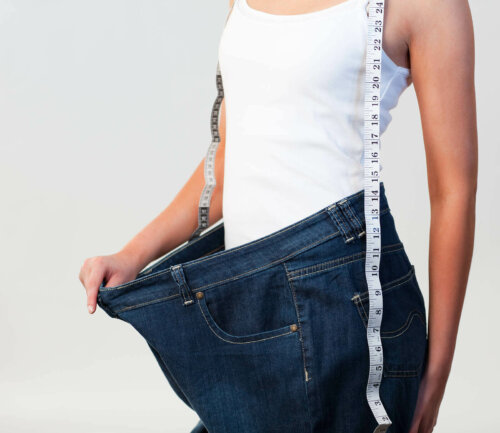Five Steps to Trim Your Waistline in Just One Month

In order to trim your waistline in a month or other specified period of time, you need to understand that it isn’t necessary to put your health at risk. Many times, you might want immediate results so badly that you don’t stop to think that perhaps, with the methods you choose, although you lose weight, you make yourself more vulnerable to discomfort and health problems.
In addition, try to be aware that when you gain weight, extra fat doesn’t always build up in the same parts of the body. It depends on certain factors like your genetic makeup, food, exercise habits, and hormonal changes.
So, is it possible to reduce your waistline in a month without being unhealthy? How can you do it? To find out the answer, be sure to read everything we’re going to tell you below.
Trim your waistline while taking care of yourself

Furthermore, if you tend to accumulate fat around the abdomen, you’ll wind up losing fat from other parts of the body and your belly fat will stubbornly remain.
Only through a combination of the right diet and an appropriate exercise routine can you lose weight, look and feel great. To help you with that, here are some key tips to help you!
Read more about: The Benefits of Exercise
1. Eat 80%
Eating 80% means that you need to get used to not feeling full at the end of a meal, but staying a little bit hungry and not until you’re so full you feel you’ve eaten enough to last two days or more.
To do this, you need to learn to eat properly, chewing your food, being relaxed and unhurried while you eat, and sitting without any major distractions (such as television, cell phone, or other electronic devices). Keep in mind that eating while looking at a screen has been shown to increase the risk of overeating.
The ideal spot to reach is when you no longer feel hunger but could continue to eat a little bit more – dessert, for example.
Eating 80% helps you to progressively reduce your waistline, prevent inflammation, feel lighter, and feel less sleepy after your meals. It’ll also help you control your cravings for snacks.
2. Get more protein and good fats

When you want to lose weight, you usually think about reducing calories and only eating salads. More and more studies have shown that low-calorie diets are unhealthy and often cause a rebound effect; so you tend to regain that lost weight – and then some.
Eating protein helps trim your waistline, but you need to do so in a healthy way. Always choose to get most of your protein from vegetable sources (legumes, nuts, avocado), as well as eggs, cheese, seeds, and other sources of protein, amino acids, and healthy fats.
Healthy fats speed up your metabolism and help you lose weight. So, be sure to also include these in your regular diet.
Also important: Six Body Parts You Should Massage
3. Don’t sit for more than 45 minutes at a time
A sedentary lifestyle will make you fat, especially around the waist. Sitting for hours and hours in a row contributes to weight gain throughout the abdominal area. In addition, it’s very detrimental to your long-term health.
To avoid this, set an alarm for every 45 minutes to remind yourself to get up from your chair and do some type of exercise or movement. Walk a bit, stretch, go to the kitchen and drink water…
It’s highly recommended you do some kind of medium intensity exercise. Do them at least twice a week to get your whole body moving and in shape. It’s also important that you maintain good posture. This is because if your lumbar region weakens, it can also increase the size of your waist.
Keep in mind that high-intensity intervallic exercise is capable of stimulating weight loss, according to a study published in Obesity Reviews.
4. Trim your waistline by massaging around your waist

In some cases, poor circulation or lymphatic drainage can occur in the abdominal region, and regular massages may actually help you lose some of that volume. You can perform dry massages or use oils or lotions.
You can also add a few drops of lemon or rosemary essential oil, which helps eliminate fat and improve circulation by enhancing the effects of massage. Clay masks are also very effective.
In addition, you’ll need to do exercises. These include both localized and general to work your body, develop endurance and improve your overall fitness.
5. Regulating your hormones
Women going through menopause suffer from an increase in abdominal fat due to hormonal changes.
There are some natural supplements that can help you regulate your hormones, such as sage, maca root, and others, however, we recommend consulting a doctor before trying any of them, since in some cases they could be counterproductive and cause adverse reactions.
It’s possible to trim your waistline
Do you still want to trim your waistline, but without compromising your health? Then apply our tips! Please note these tips may be modified according to your doctor’s indications.
All cited sources were thoroughly reviewed by our team to ensure their quality, reliability, currency, and validity. The bibliography of this article was considered reliable and of academic or scientific accuracy.
- Martines RM., Machado PR., Neri DA., Levy RB., et al., Association between watching TV whilst eating and children’s consumption of ultraprocessed foods in United Kingdom. Matern Child Nutr, 2019.
- Kroeger CM., Hoddy KK., Varady KA., Impact of weigth regain on metabolic disease risk: a review of human trials. J Obes, 2014.
- Wewege M., Berg R., Ward RE., Keech A., The effects of high intensity interval training vs moderate intensity continuous training on body composition in overweight and obese adults: a systematic review and meta analysis. Obes Rev, 2017. 18 (6): 635-646.
This text is provided for informational purposes only and does not replace consultation with a professional. If in doubt, consult your specialist.








